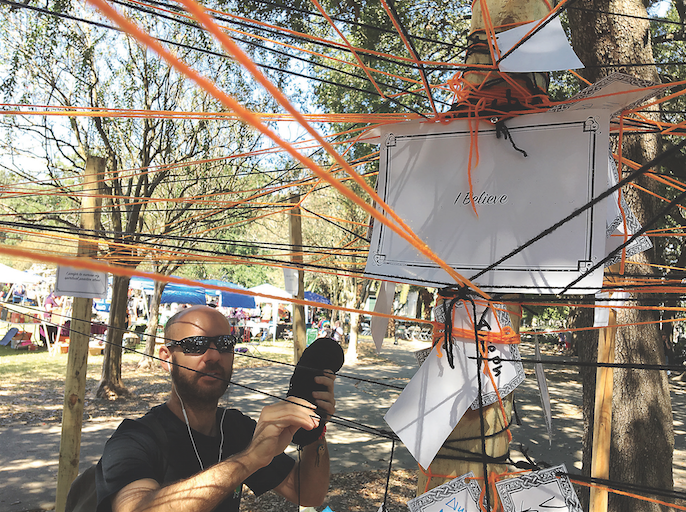Community gathers to show pagan pride
A festival attendee adds his own yarn to the faith web, Pagan Pride Festival’s first ever art installation. The festival gave people an opportunity to gather and discuss their beliefs.
October 24, 2016
Pagans and non-pagans alike gathered together for a festival held in Washington Square Park on Saturday, Oct. 8 to celebrate the fourth annual Greater New Orleans Pagan Pride Day.
Paganism in its modern form, also referred to as Neopaganism, is a group of religious movements influenced by or derived from various historic Pagan beliefs of pre-modern society. Adherents rely on pre-Christian, folkloric and ethnographic sources to varying degrees.
Since the spread of Christianity, Pagans have been a marginalized group. From witch-hunts to the caricatures of their beliefs in popular culture, Pagans have often been negatively represented.
“Pagan Pride Day was created to dispel [this] negative propaganda and show outsiders that Pagans are just ordinary people,” said Emily Snyder, president of New Orleans’ Pagan Pride Project and a coordinator of the festival.
Snyder says that the festival serves as a place where people of all paths can come together to celebrate and discuss their beliefs without fear. It is also a way for the group to establish a new, more accurate image within their city.
Like many other religious followers, Pagans are advocates of charity work. This year they accepted donations for The Desmond Project, a New Orleans-based charity aimed to end hunger across the city. Donations for the Love a Pit Foundation, an animal rescue dedicated to finding homes for pitbulls in need, were also collected. Both charities are non-profit and have no
religious affiliation.
As most celebratory festivals do, Pagan Pride featured guest speakers, musical performances, merchants, food and activities for children. It also featured unique events, such as divinations and rituals. Festival-goers could have their cards read and receive blessings.
The Lamplight Circle, a Pagan social, discussion and activism forum, held Pagan Pride’s first ever art installation, which was called a
faith web.
Festival attendees could take a string, orange for those who identify with Paganism and black for non-Pagans, and string it around wooden pillars that held signs representing their beliefs. All strings started in the center with the “I believe” post and could be wrapped around others.
Some included, “I believe in reincarnation,” “I believe in multiple deities” and “I believe in a single deity.”
This year’s feature guest speaker was Rev. Bill Duvendack, astrologer, author and president of the Astrological Association in St. Louis.
After Duvendack concluded his lecture about spirits and spirit contact, he spoke about Paganism and its future.
“We are moving into an era of a society of variety,” Duvendack said. “Today, people are much more willing to listen and accept people and their beliefs. When I was growing up, it wasn’t like that.”
“People still have these crazy ideas that Pagans are devil worshipers, but through community events and outreach like Pagan Pride they discover that Paganism is just like any other religion,” Duvendack said.
Duvendack said that if he had one thing he wished to convey to non-Pagans, it is that “Paganism has the same fundamental teaching that all religions share: treat others as you would like to be treated.”
The future for both Paganism and religious acceptance looks bright but will require effort.
Jose Campos, Loyola English junior and a member of the New Orleans School for Esoteric Arts, expressed a similar concern for religious acceptance that Pagans share. She says that Loyola needs more exposure to Paganism as a religion.







